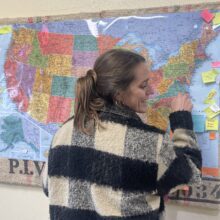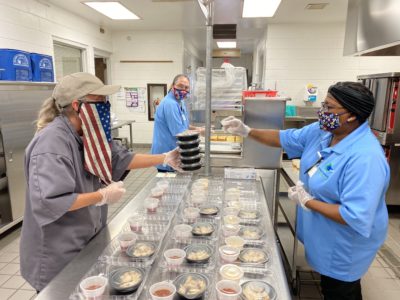Share this story
- The Rural Food Forum gathered together rural advocates, policymakers, education leaders, and more to discuss how we can have healthy food for all students — and a more equitable experience for those growing the food.
- One silver lining of the pandemic? Federal school meal waivers showed schools how they could feed students and their families better.
|
|
The Green Rural Redevelopment Organization (GRRO) hosted the Rural Food Forum at Vance-Granville Community College last week. The day brought together policymakers, nonprofits working for nutrition equity, education leaders, rural advocates, and more to explore the issues and opportunities surrounding rural food systems.
It was also a day of celebration, announcing the creation of the Eva Clayton Rural Food Institute. The Honorable Eva Clayton is the first African American woman to represent North Carolina in Congress and has championed rural and agricultural interests her entire career. The institute will support the work of GRRO and continue to advocate for farmers and the region, with a commitment to increase access to healthy food for all.

A look at the life of a farmer
Schools need farmers to support nutrition programs, and one focus of the convening was the mounting challenges for farmers. Nearly 66% of our current farmers are at an age where they are about to retire or leave the profession, said Archie Hart, director of the Small Farms Policy Office at the N.C. Department of Agriculture Consumer Services.
Zooming out from the present, “from 1900 to 1997 the number of Black farmers declined by 98%, the steepest decline for any race,” according to the Congressional Research Service.
From 2001-2016, more than 731,000 acres of agricultural land were developed or compromised in North Carolina, according to The State of the States. The American Farmland Trust also reports North Carolina ranks second in the nation in potential agricultural land lost by the year 2040.
The forum covered issues like land ownership, economic insecurity, inability to get insurance, and historic inequities around resources for marginalized farming communities.
“We are looking at losing land and those people who know how to grow food,” Hart said.
According to the USDA Economic Research Service, “On average, U.S. farmers received 16.0 cents for farm commodity sales from each consumer dollar spent on domestically produced food in 2020.”
Hart believes a way to raise that farm share would be to keep product in the hands of farmers for longer.
Stacy Dean, deputy under secretary at USDA’s Food, Nutrition, and Consumer Services gave examples of how her department is trying to do just that. With respect to the supply chain and keeping it in the hands of local farmers, she believes its also important to keep it in the hands of the rural community, rather than ship that product across the country to be processed and then shipped back.
The USDA is working with regional business centers to help communities apply for grants and build processing centers to keep product, processing, and sales in those local communities.
Dean touched upon the silver lining of the pandemic, as did many others. The urgency of COVID-19 forced the government to move quicker, suspending regular oversight, and showed them what works with respects to feeding families and food access.
“We don’t have to go back to a space where we made it impossible for ourselves to innovate and be creative,” she said.
‘Let’s just feed the kids’
What else did we learn during the pandemic with regards to school nutrition and food programs?
At the beginning with school buildings closed, the USDA implemented federal waivers that offered districts flexibility to fund and distribute breakfasts and lunches to students at no cost to them. Those waivers continued until the end of summer of 2022, and most districts are going back to the pre-pandemic application process for families that qualify.
Morgan Gramann, executive director at North Carolina Alliance for Health, said when they were able to reduce barriers, whether that be suspending the rule of having to watch students eat or making it easier for families to access food, they were feeding more people.
… We didn’t see food insecurity rise, and it wasn’t because people weren’t losing their jobs or because there was no food insecurity, it was because we were feeding people. And we were putting these programs into place to allow that to happen and reducing barriers to being able to access them.”
Morgan Gramann, executive director at North Carolina Alliance for Health
Dr. Linden Thayer is the assistant director of food systems planning at Durham Public Schools. She has been in the position since July, and said it was created because the district recognized that school nutrition, like many other federally funded nutrition programs, is notorious for not asking the end user what it needs. She said she is there to center the conversation around student and family voice.
Thayer said the pandemic policy changes made it easier to serve kids. For summer meal programs, the district was sending out hundreds of more meals and reaching a lot more families.
She is hopeful because they saw what worked, and if the current Child Nutrition Reauthorization (CNR) were to pass and become part of new legislative efforts, all of North Carolina schools would qualify for free meals for everyone.
“We’re interested in feeding all students in a way that school lunch becomes like math or science, right? It’s part of the school day, it’s part of your learning and education… One day, my dream is that we do not think of school meals as a poverty program, which is how it started.”
Dr. Linden Thayer, Durham Public Schools
School nutrition expands beyond K-12, and representing those higher education entities were Michelle Schroeder-Moreno, professor at N.C. State University and assistant director of educational programs for the Center for Environmental Farming Systems (CEFS), and Tanya Weary, executive director of The VGCC Foundation.
“I just want to stop for a moment and acknowledge we’re not just talking about local food and schools and education,” Schroeder-Moreno said. “We’re talking about transforming our food systems step by step and being persistent about it.”
Weary said “if our students are hungry, they’re not going to be successful.” The community college serves four counties, and within that group, 19,000 people are considered food insecure, according to the Food Bank of North Carolina. During the pandemic, the college placed a food bank on the main campus.
“We know that school meals are the healthiest meals that are available in America right now,” Gramann said. “There have been studies that show the healthiest place that people eat is in a school… and so let’s just feed the kids.”




